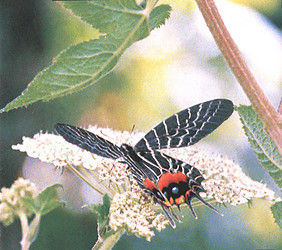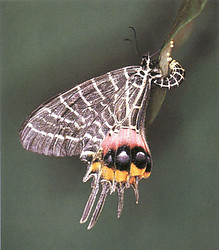Bhutanitis
Vazrick Nazari


This tree diagram shows the relationships between several groups of organisms.
The root of the current tree connects the organisms featured in this tree to their containing group and the rest of the Tree of Life. The basal branching point in the tree represents the ancestor of the other groups in the tree. This ancestor diversified over time into several descendent subgroups, which are represented as internal nodes and terminal taxa to the right.

You can click on the root to travel down the Tree of Life all the way to the root of all Life, and you can click on the names of descendent subgroups to travel up the Tree of Life all the way to individual species.
For more information on ToL tree formatting, please see Interpreting the Tree or Classification. To learn more about phylogenetic trees, please visit our Phylogenetic Biology pages.
close boxPhylogeny after Nazari et al., 2007.
Introduction
The genus Bhutanitis has four recognized species distributed from northern India and China to Thailand (Häuser et al., 2005). All four species have been protected by law for a long time (Collins and Morris, 1985; Coote, 2000), although recently only two of these species (B. ludlowi and B. mansfieldi) are listed by IUCN as vulnerable or data deficient (IUCN, 2004; UNEP-WCMC, 2006).
Discussion of Phylogenetic Relationships
A recent molecular study (Zhu et al., 2005) investigates the phylogenetic relationships among the species of Bhutanitis using sequences of COI mitochondrial gene, and provides evidence for synonymy of the taxon Bhutanitis mansfieldi pulchristrata with nominal B. m. mansfieldi. Nazari et al. (2007) provide further evidence for the phylogeny of Bhutanitis species based on a much larger dataset of molecular and morphological characters.
Nomenclature
Blanchard (1871) described the species thaidiana under new genus Armandia. The generic name Armandia Blanchard, 1871 is invalid as it is a junior homonym of Armandia Filippi, 1862 (Hemming, 1967). Atkinson (1873) described the species lidderdalii under a new genus Bhutanitis.
After the description of Armandia mansfieldi by Riley in 1939, based on an unlabeled specimen from China, doubts were raised as to whether this new species belonged to Bhutanitis since it apparently shared many morphological characters with Luehdorfia. In 1980 Hiura described a new genus, Yunnanopapilio (Type species: B. mansfieldi). Based on genitalic characters, Yunnanopapilo was later synonymized with Bhutanitis (Saigusa and Lee, 1982). Further evidence on the life history of B. mansfieldi supported this decision (Igarashi, 2003). Lee (1986) uses the generic names Yunnanitis and Sinonitis for B. mansfieldi and B. thaidiana with no reference to their authorship and publications. Since these names do not seem to be indicated anywhere else, they are treated as numina nuda here.
References
Atkinson, W.S., 1873. Description of a new genus and species of Papilionidae from the south-eastern Himalayas. Proc. Zool. Soc. Lond. 1873: 570-572.
Blanchard, E., 1871. Remarques sur la faune de la principauté thibétaine du Moupin. C.r.hebd. Séanc. Acad. Sci., Paris, 72: 807-813.
Collins, N.M., Morris, M.G., 1985. Threatened Swallowtail Butterflies of the World: The IUCN Red data book. Gland, Switzerland. 401 pp.
Coote, L., 2000. CITES identification guide - Butterflies: Guide to the Identification of Butterfly Species Controlled Under the Convention on International Trade in Endangered Species of Wild Fauna and Flora. Ottawa: Canadian Wildlife Service.
Häuser, C.L., de Jong, R., Lamas, G., Robbins, R.K., Smith, C., Vane-Wright, R.I., 2005. Papilionidae – revised GloBIS/GART species checklist (2nd draft). Accessed December 2005.
Hemming, A.F., 1967. The generic names of the butterflies and their type-species (Lepidoptera: Rhopalocera). Bull. Br. Mus. Nat. Hist. Ent. Suppl. 9: 509 pp.
Hiura, I., 1980. A phylogeny of the genera of Parnassiinae based on analysis of wing pattern, with description of a anew genus (Lepiopdtera: Papilionidae). Bulletin of the Osaka Museum of Natural History 33: 71-85.
Igarashi, S., 2003. Life history of Bhutanitis mansfieldi in comparison with those of related species. Butterflies (Publication of the Butterfly Society of Japan), 35:20-39.
IUCN red list of threatened species 2004. Accessed January 2006.
Lee, C., 1986. First report on the life histories and phylogenetic position of two Chinese Papilionidae, Bhutanitis mansfieldi and B. thaidiana. Yadoriga 126: 17-21.
Nazari, V., Zakharov, E.V., Sperling, F.A.H., 2007. Phylogeny, historical biogeography, and taxonomic ranking of Parnassiinae (Lepidoptera, Papilionidae) based on morphology and seven genes. Molecular Phylogenetics and Evolution, 42: 131-156.
Riley, N.D., 1939. A new species of Armandia (Lep. Papilionidae). Entomologist 72: 207-208.
Saigusa, T., Lee, C., 1982. A rare papilionid butterfly Bhutanitis mansfieldi (Riley), its rediscovery, new subspecies and phylogenetic position. Tyô to Ga 33: 1-24.
UNEP-WCMC species database, 2006. Accessed January 2006.
Zhu, L.X., Wu, X.B., Yan, P., 2005. Molecular phylogenetic relationships among four species of Bhutanitis (Lepidoptera: Papilionidae) based on partial COI gene sequence. Acta Zootaxonomica Sinica 31: 25-30.
Title Illustrations

| Scientific Name | Bhutanitis lidderdalii |
|---|---|
| Location | Bhutan |
| Reference | Igarashi, S.,1985. Some ecological observations on Bhutanitis lidderdalei inhibiting misty forests. Yadoriga 123: 24-26. |
| Acknowledgements | Image reproduced here with permission of the author |
| Specimen Condition | Live Specimen |
| Copyright | © Suguru Igarashi |
| Scientific Name | Bhutanitis lidderdalii |
|---|---|
| Location | Chasilakha, Bhutan |
| Reference | Igarashi, S., 1989. On the life histroy of Bhutanitis lidderdalei Atkinson in Bhutan. Tyo To Ga 40(1): 1-21. |
| Acknowledgements | Image reproduced here with permission of the author |
| Specimen Condition | Live Specimen |
| Behavior | Ovipositing |
| Sex | Female |
| Copyright | © Suguru Igarashi |
About This Page
Vazrick Nazari

Canadian National Collection of Insects, Arachnids and Nematodes, Ottawa, Canada
Correspondence regarding this page should be directed to Vazrick Nazari at
nvazrick@yahoo.com
Page copyright © 2006 Vazrick Nazari
 Page: Tree of Life
Bhutanitis .
Authored by
Vazrick Nazari.
The TEXT of this page is licensed under the
Creative Commons Attribution License - Version 3.0. Note that images and other media
featured on this page are each governed by their own license, and they may or may not be available
for reuse. Click on an image or a media link to access the media data window, which provides the
relevant licensing information. For the general terms and conditions of ToL material reuse and
redistribution, please see the Tree of Life Copyright
Policies.
Page: Tree of Life
Bhutanitis .
Authored by
Vazrick Nazari.
The TEXT of this page is licensed under the
Creative Commons Attribution License - Version 3.0. Note that images and other media
featured on this page are each governed by their own license, and they may or may not be available
for reuse. Click on an image or a media link to access the media data window, which provides the
relevant licensing information. For the general terms and conditions of ToL material reuse and
redistribution, please see the Tree of Life Copyright
Policies.
- First online 07 July 2006
- Content changed 07 July 2006
Citing this page:
Nazari, Vazrick. 2006. Bhutanitis . Version 07 July 2006 (under construction). http://tolweb.org/Bhutanitis/65398/2006.07.07 in The Tree of Life Web Project, http://tolweb.org/









 Go to quick links
Go to quick search
Go to navigation for this section of the ToL site
Go to detailed links for the ToL site
Go to quick links
Go to quick search
Go to navigation for this section of the ToL site
Go to detailed links for the ToL site